
Grouseland, the William Henry Harrison Mansion and Museum, is a National Historic Landmark important for its Federal-style architecture and role in American history. The two-story, red brick home was built between 1802 and 1804 in Vincennes, Indiana, for William Henry Harrison (1773–1841) during his tenure from 1801 to 1812 as the first governor of the Indiana Territory. The residence was completed in 1804, and Harrison reportedly named it Grouseland due to the abundance of grouse in the area.
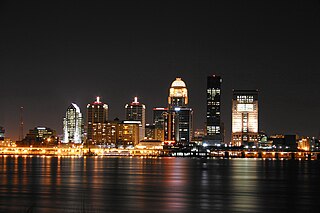
Downtown Louisville is the largest central business district in the Commonwealth of Kentucky and the urban hub of the Louisville, Kentucky Metropolitan Area. Its boundaries are the Ohio River to the north, Hancock Street to the east, York and Jacob Streets to the south, and 9th Street to the west. As of 2015, the population of Downtown Louisville was 4,700, although this does not include directly surrounding areas such as Old Louisville, Butchertown, NuLu, and Phoenix Hill.

The Cornelius Low House is a Georgian manor in Piscataway, Middlesex County, New Jersey, United States, built in 1741 at Raritan Landing. The Cornelius Low House is listed on the New Jersey Register of Historic Places and National Register of Historic Places. The house currently holds the Cornelius Low House/Middlesex County Museum.
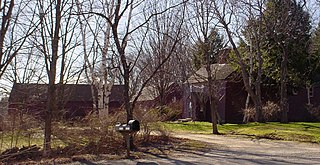
The John Sedgley Homestead is a historic homestead property at Scituate and Chases Pond Road in the York Corner area of York, Maine. Its oldest structure built in the late First Period, probably c. 1715, it is the oldest homestead in the State of Maine that is still in its original setting. Historically the homestead included a cape, farm home, carriage house, stables building, two outbuildings, and a large land holding, all of which is still existing today. The property was listed on the National Register of Historic Places in 1976.

The Old York Gaol is a former colonial prison at Lindsay Road and Main Street in York, Maine. Its oldest portion dating to about 1720, it is one of the oldest prison buildings in the United States, and one of the oldest public buildings in the state of Maine. It was designated a National Historic Landmark in 1968. It is owned by the Museums of Old York and is open for tours between May and October.

Fort Kent, located at the confluence of the Fish and Saint John rivers in the town of Fort Kent, Maine, United States, is the only surviving American fortification built during the border tensions with neighboring New Brunswick known as the Aroostook War. It is preserved as the Fort Kent State Historic Site, which features an original log blockhouse that is open for visits in the summer. The fort was added to the National Register of Historic Places in 1969 and declared a National Historic Landmark in 1973.

The Burnt Coat Harbor Light Station is a lighthouse on Swan's Island, Maine. It is located on Hockamock Head, at the entrance to Burnt Coat Harbor and at the end of Harbor Road. Hockamock Head is a peninsula extending south from the center of the island, dividing the island's main harbor from Toothacker Bay. The light marks the entrance to Burnt Coat Harbor. It was built in 1872, and is a well-preserved 19th-century light station. It was listed on the National Register of Historic Places in 1988.

Prospect Harbor Point Light is a lighthouse on Prospect Harbor Point, which divides Sand Cove from Inner Harbor at the head of Prospect Harbor on the southern shore of Gouldsboro, Maine. Also known as Prospect Harbor Light, it was first established in 1850. The present structure was built in 1891. It was listed on the National Register of Historic Places as Prospect Harbor Light Station in 1988.
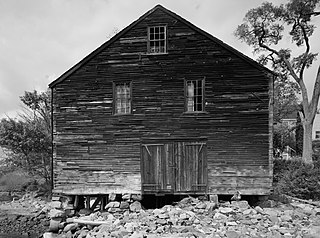
The Gerrish Warehouse was a historic 18th-century warehouse, located on Pepperrell Cove in Kittery Point, Maine. Built c. 1710, it was one element of the Pepperrell family's shipping empire, notably run in the mid-18th century by Sir William Pepperrell. Converted into a ship chandlery in the 19th century, it was sold to the Maine Maritime Museum in 1976, and was added to the National Register of Historic Places in 1977. The museum's plan to move the building by barge to a new location was judged infeasible, and it was subsequently demolished after the museum had recovered its contents. It was removed from the National Register in 2015.

The Lock Tender's House and Canal Store Ruin is located on Canal Road in High Falls, New York, United States. It is a complex along the former route of the Delaware and Hudson Canal built in the middle of the 19th century.

The Bowman House is a historic house museum on Bowman Lane, off Maine State Route 128, in Dresden, Maine, United States. It was built in 1762, early in the area's colonial settlement history, and later served as the office of an ice harvesting business. The house was listed on the National Register of Historic Places on April 7, 1971, under the name Bowman-Carney House. It is now a museum owned and managed by Historic New England.
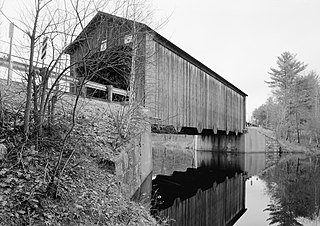
The Hancock–Greenfield Bridge is a historic covered bridge carrying Forest Road over the Contoocook River at the town line between Hancock and Greenfield, New Hampshire. The New Hampshire Department of Transportation covered bridge database refers to it as County Bridge. Built in 1937, it is the first wooden covered bridge in the northeastern United States to use modern engineering techniques. The bridge was listed on the National Register of Historic Places in 1981.

The Islesford Historical Museum and Blue Duck Ships' Store are related historical exhibits on Little Cranberry Island in Maine, USA, within the boundaries of Acadia National Park.

The Louis St. Gaudens House and Studio is a historic house at Dingleton Hill and Whitten Roads in Cornish, New Hampshire. The 2+1⁄2-story gambrel-roofed wood-frame structure was designed by Moses Johnson and built in 1793–94 at the Shaker village in Enfield, New Hampshire. At that site the building served as the main meeting space for the Shakers, with a main meeting space on the ground floor, offices on the second floor, and guest living quarters in the attic space. The building is similar in construction to buildings designed by Johnson for the Shaker villages in Canterbury, New Hampshire and Sabbathday Lake, Maine.
The Higgins Barn is a historic English barn at 256 Oak Hill Road in Indian Point, a rural area in western Bar Harbor, Maine. It is estimated to have been built c. 1810 by Ichabod Higgins, and is one of the oldest structures in the area, dating to the first settlement period of Indian Point. The barn was listed on the National Register of Historic Places in 2004.

The Seaman-Drake Arch, also known as the Inwood Arch, is a remnant of a hilltop estate built in 1855 in the Inwood neighborhood of Manhattan, New York City by the Seaman family. Located at 5065 Broadway at West 216th Street, the arch was built from Inwood marble quarried nearby. It is 35 feet (10.67 m) tall, 20 feet (6.10 m) deep, and 40 feet (12.19 m) wide, and was once the gateway to the estate.
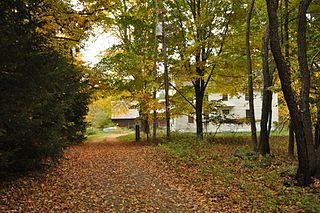
The Frost Garrison and House are a cluster of colonial-era buildings on Garrison Drive in Eliot, Maine. Sited on Frost's Hill, the complex includes a c. 1778 house, and two structures, the oldest dating to 1735, constructed as strongholds against Native American attacks. The older one is the only known surviviving garrison built for the defense of a single family. The house is also the ancestral home of poet Robert Frost, who is known to have visited the area. The complex was listed on the National Register of Historic Places in 1971. His niece, Mara Frost Marshall, was also born there.
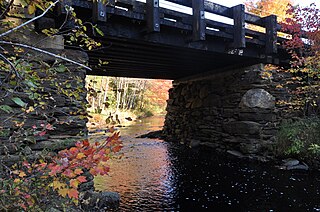
The Grist Mill Bridge is a historic bridge in Lebanon, Maine, carrying Little River Road across the Little River. Although the bridge has a 20th-century wooden deck on rubblestone abutments and pier, it is functionally similar to the bridge's original deck, which was also a wooden structure that may have existed as early as 1774. The bridge was listed on the National Register of Historic Places as a rare example of a bridge in the state with some essential 18th-century elements intact.
The Josiah K. Parsons Homestead is a historic house overlooking Greenleaf Cove in Westport, Maine. Built in 1792 by a veteran of the American Revolutionary War, it is a well-preserved example of early Federal period architecture. The property also includes an early 19th-century trading post with original fixtures, and was used in the 20th century for pioneering research in the neurophysiology and communications capabilities of dolphins by John C. Lilly. It was listed on the National Register of Historic Places in 1982.



















